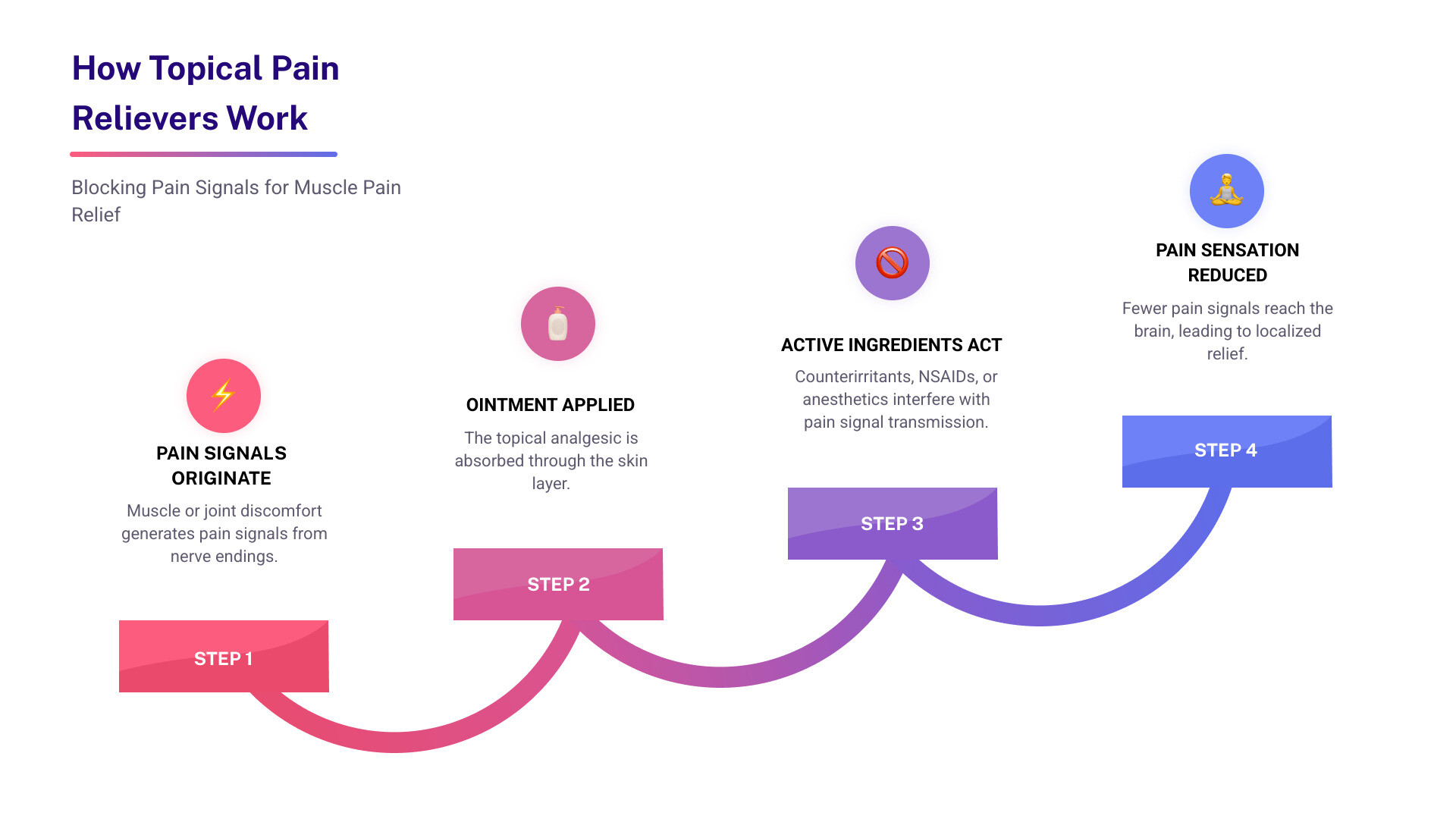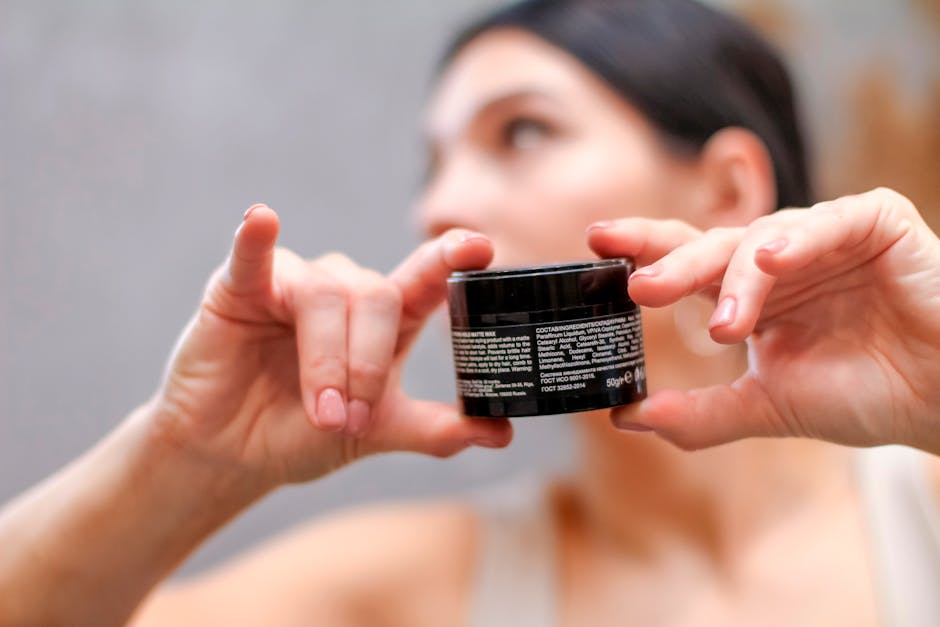Why Finding the Best Muscle Pain Ointment Matters
Best muscle pain ointment options offer fast, targeted relief for sore muscles, joint pain, and nerve discomfort without pills. Whether it's post-workout soreness, a chronic condition like sciatica, or an acute strain, the right topical product can help you return to your daily activities with less pain.
Quick Answer: Top Muscle Pain Ointments at a Glance
| Product | Best For | Key Ingredient | Price Range |
|---|---|---|---|
| Biofreeze Professional Strength | Overall relief | 5% Menthol | $10-$15 |
| Voltaren Arthritis Pain Gel | Arthritis & joint pain | 1% Diclofenac (NSAID) | $15-$20 |
| Neuropasil | Muscle & nerve pain (natural) | Menthol, Aloe, Urea | $20-$30 |
| Tiger Balm Ultra Strength | Budget-friendly | 11% Camphor, Menthol | $5-$10 |
| Tylenol Precise | Numbing relief | 4% Lidocaine | $12-$18 |
Muscle pain can disrupt your life, but topical analgesics can be highly effective, with research showing they may relieve pain by up to 50 percent. These products absorb through the skin to block pain signals, reduce inflammation, or create a cooling/warming sensation that distracts from the discomfort.
The market is filled with options featuring active ingredients like menthol, camphor, diclofenac, and lidocaine. Choosing the best muscle pain ointment depends on your pain type, preferred sensation, and skin sensitivity.
I'm Tony Enrico, founder of Neuropasil. I've dedicated my career to developing topical solutions for muscle and nerve pain. My goal is to help you find the right ointment to get back to the activities you love, free from discomfort.

Best muscle pain ointment further reading:
- body ache cream
- body pain cream
- foot pain cream
How Do Muscle Pain Ointments Provide Relief?
When you feel muscle pain, your nervous system is sending signals to your brain. The best muscle pain ointment products work by interrupting this communication. As physical therapist Dr. Brad Whitley explains, they interfere with the neural pathways that transmit pain signals, effectively turning down the volume on your pain perception.
This is achieved through active ingredients absorbed by your skin:
Counterirritants: Ingredients like menthol and camphor create a strong cooling or warming sensation. This sensory distraction makes your brain pay less attention to the underlying ache. They stimulate skin receptors, blocking pain sensations from reaching your conscious awareness.
Anesthetics: Lidocaine is a prime example. It works by numbing the nerves in the applied area. The maximum over-the-counter strength (4%) acts as a local anesthetic, temporarily silencing pain signals, which is especially effective for nerve-related discomfort.
NSAIDs (Non-Steroidal Anti-Inflammatory Drugs): Unlike the other types, topical NSAIDs like diclofenac address a root cause of pain: inflammation. Research on topical NSAIDs shows they block the production of prostaglandins, which are chemicals that trigger pain and inflammation. This makes them ideal for arthritis and strains.
These ingredients come in various formats—creams, ointments, gels, balms, sprays, and patches. Gels absorb quickly, creams are great for massage, and patches offer long-lasting, mess-free relief. The best format is simply the one you'll use consistently.
Cooling vs. Warming: What's the Difference?

The choice between "cooling" and "warming" isn't just marketing; it's about different ingredients for different purposes.
Cooling relief comes from menthol and camphor, which activate cold receptors in your skin. This icy sensation helps reduce local blood flow, making it perfect for acute injuries like sprains, strains, and post-workout soreness where swelling is a concern. It's like a convenient, portable ice pack.
Warming relief increases blood flow to an area. Ingredients like capsaicin (from chili peppers) and methyl salicylate achieve this. The warmth helps relax tight muscles, improve flexibility, and soothe the persistent, dull aches of chronic pain, stiffness, or arthritis. It's like a heat pack in a tube.
The choice between cooling and warming often comes down to personal preference and what feels best for your specific pain.
Key Ingredients in Top-Rated Muscle Pain Ointments
Understanding the active ingredients in a pain relief ointment helps you choose the right one for your discomfort. Here’s a breakdown of what to look for—and what to avoid.
Common Active Ingredients:
Counterirritants (Menthol & Camphor): These create a strong cooling or warming sensation that distracts your brain from the pain. They provide fast, temporary relief, making them ideal for acute soreness. Menthol is the star in products like Biofreeze, while camphor is prominent in Tiger Balm.
Anesthetics (Lidocaine): Available up to 4% over-the-counter, lidocaine blocks nerve signals to create a numbing effect. This makes it highly effective for surface-level nerve pain, such as in carpal tunnel syndrome or diabetic neuropathy.
NSAIDs (Diclofenac): As the only topical NSAID available without a prescription in the U.S., diclofenac (found in Voltaren) targets pain by reducing inflammation. Research shows it's particularly helpful for localized arthritis and muscle strains.
Natural Ingredients: Many formulations now include proven natural extracts. Arnica is an herb known to reduce inflammation and bruising. CBD (Cannabidiol) may help by interacting with the body's endocannabinoid system to alter pain perception. Capsaicin, from chili peppers, provides warming relief and can desensitize nerve endings over time.
Ingredients You Might Want to Avoid:
- Strong Fragrances: The classic medicinal smell can be overwhelming or irritating for some. Look for fragrance-free options if you're sensitive.
- Parabens and Phthalates: While generally considered safe in small amounts, some people prefer to avoid these synthetic preservatives.
- Artificial Dyes: These serve no therapeutic purpose and can occasionally trigger skin reactions.
Pro Tip: Always perform a patch test on a small area of skin before applying a new product widely. Wait 24 hours to check for any irritation.
The Best Muscle Pain Ointment of 2025
You've learned how muscle pain ointments work and what ingredients matter most. Now comes the exciting part: finding the perfect product for your specific needs. We've researched and tested numerous options to bring you our top picks for the best muscle pain ointment available this year.

Whether you're dealing with post-workout soreness, chronic arthritis pain, nerve discomfort, or just need a reliable option that won't empty your wallet, there's a product here that can help. Each of these selections excels in its category, offering unique benefits that set it apart from the competition.
Best Overall: Biofreeze Professional Strength Pain Relief Gel
Recommended by physical therapists and athletes alike, Biofreeze Professional Strength Pain Relief Gel is a top choice for fast, cooling relief. Its 5% menthol formula delivers an immediate icy sensation that interferes with pain signals, providing relief within minutes. The non-greasy gel absorbs quickly and includes aloe and vitamin E to condition the skin. While the menthol scent is strong initially, its effectiveness for everything from back pain to muscle soreness makes it a standout. The main drawback is the need for more frequent reapplication compared to some warming products.
Best for Arthritis: Voltaren Arthritis Pain Gel
For joint pain caused by arthritis, Voltaren Arthritis Pain Gel offers a unique advantage. It contains 1% diclofenac sodium, an NSAID that reduces the inflammation causing the pain, rather than just masking it. Approved by the FDA for arthritis pain, it's proven to relieve pain, improve mobility, and reduce stiffness. The gel has a minimal scent and penetrates deep into joints. A thoughtful, easy-twist cap is helpful for those with hand pain. Voltaren is specifically for arthritis and should be used as directed, typically not for more than seven days for acute injuries without a doctor's advice.
Best Natural Option for Muscle & Nerve Pain: Neuropasil
We created Neuropasil to provide a powerful, natural alternative for both muscle and nerve pain. Our formula combines menthol for immediate cooling with the soothing properties of aloe vera and the moisture-enhancing benefits of urea. This synergy helps the active ingredients penetrate deeply to reach the source of pain. Customers use Neuropasil for a wide range of conditions, including neuropathy, sciatica, fibromyalgia, plantar fasciitis, and general aches. Athletes also rely on it for quick muscle recovery. The cream absorbs fast for targeted relief, offering results that rival synthetic options without harsh chemicals.
Explore Neuropasil for natural, fast-acting relief.
Best Budget-Friendly: Tiger Balm Ultra Strength Pain Relieving Ointment
Tiger Balm is a classic for a reason: it delivers effective pain relief without a high price tag. The Ultra Strength formula contains 11% camphor and menthol, creating a potent cooling sensation that penetrates deep into muscles. A small amount goes a long way, making one jar very economical. It's excellent for localized aches and provides relief within about 20 minutes. The trade-offs are its very strong, medicinal scent and a greasy texture that can potentially stain clothing. For affordable, reliable relief, however, it's hard to beat.
Best with Lidocaine: Tylenol Precise Pain Relieving Cream
When you just want to turn the pain off, Tylenol Precise Pain Relieving Cream is an excellent choice. It uses 4% lidocaine, the maximum non-prescription strength, to numb nerve endings and block pain signals. This makes it especially useful for nerve pain and localized discomfort. The product is designed for convenience with a smooth roller-ball applicator for mess-free use, even on hard-to-reach areas like the back. It's also fragrance-free and non-greasy. A recent study showed that lidocaine cream can be helpful for neck pain originating from muscles, making it a top choice for targeted numbing relief.
How to Choose and Use the Best Muscle Pain Ointment
Finding your perfect muscle pain ointment isn't quite like picking a favorite ice cream flavor—though I wish it were that simple! Your ideal product depends on your specific pain, your preferences, and even your lifestyle. Let's walk through how to make the smartest choice and use it safely for maximum relief.

Factors to Consider Before You Buy
- Type of Pain: For acute pain (sudden injuries, post-workout soreness), choose cooling agents like menthol to reduce inflammation. For chronic pain (persistent arthritis, stiffness), warming ingredients like capsaicin can increase blood flow and relax muscles.
- Location of Pain: Is it muscle, joint, or nerve pain? Some products, like Voltaren, are formulated for joints, while others with lidocaine or specialized formulas like Neuropasil are better for nerve discomfort.
- Active Ingredients: Decide if you prefer the distraction of a counterirritant (menthol), the numbing of an anesthetic (lidocaine), the anti-inflammatory action of an NSAID (diclofenac), or a natural approach (arnica, aloe).
- Application Method: Choose what fits your lifestyle. Creams are good for massage, roll-ons are mess-free, sprays are great for your back, and patches offer long-lasting, hands-off relief.
- Scent and Skin Sensitivity: If you're sensitive to smells, look for fragrance-free options. If you have sensitive skin, avoid harsh ingredients and always do a patch test first.
Expert Tips for Safe and Effective Application
Getting the most from your ointment means using it correctly. Follow these tips for safe and effective relief.
- Start with clean, dry skin to ensure proper absorption.
- Apply a thin layer. A little goes a long way. Gently massage it into the affected area until absorbed.
- Wash your hands thoroughly after application to avoid getting potent ingredients in your eyes or other sensitive areas.
- Never apply to broken or irritated skin. This can cause intense burning or adverse reactions.
- Do not combine with heating pads or tight bandages, as this can cause skin burns or severe irritation.
- Follow usage limits on the product label. More is not better. For example, topical NSAIDs shouldn't be used for more than seven days for acute injuries without a doctor's approval.
- Know when to see a doctor. If your pain is severe, persists for more than a few days, or doesn't improve with topical treatments, it's time to seek professional medical advice.
Frequently Asked Questions about Muscle Pain Ointments
We hear from people every day who are curious about how topical pain relief really works and whether it's right for them. Let's tackle the questions that come up most often.
How effective are topical pain relief products?
They can be very effective for mild to moderate localized pain. By delivering active ingredients directly to the source of discomfort, they provide targeted relief with potentially fewer side effects than oral medications. A comprehensive Cochrane Review supports their use, and some studies show they can reduce pain by up to 50%. While they don't cure the underlying cause of severe conditions, they provide significant symptomatic relief that can improve your quality of life.
How long does it take for muscle pain ointment to work?
This is one of the most common questions we get, and the answer is: it depends on what's in the bottle.
- Counterirritants (menthol, camphor) work the fastest, often providing a cooling or warming sensation and noticeable relief within minutes.
- Anesthetics (lidocaine) typically begin numbing the area within 5 to 10 minutes, with peak effects around the 30-minute mark.
- NSAIDs (diclofenac) can take 30-60 minutes to start working, as they reduce inflammation. Full benefits may build over several days of consistent use.
Many topical pain relievers can take between 30 minutes and 1 hour to be fully effective, though plenty of users report feeling better much sooner. Your individual body chemistry, the severity of your pain, and how well you've applied the product all play a role in timing.
Can I use muscle pain cream every day?
Always follow the product's instructions—this is our golden rule. Each label will have specific guidelines for how often and how long you should use it.
- NSAID creams like Voltaren have strict limits and generally shouldn't be used for more than 7 days for an acute injury without a doctor's guidance, due to potential systemic side effects with prolonged use.
- Counterirritant and lidocaine creams are often safe for daily use, typically up to 3-4 times per day. However, if you need daily relief for weeks on end, it's a sign you should consult a healthcare professional to address the root cause of your pain.
- For chronic conditions, discuss a long-term plan with your doctor. Many of our customers use natural-ingredient products like Neuropasil regularly, but professional medical advice is key for ongoing pain management.
Conclusion
Navigating muscle pain ointments can feel overwhelming, but with the right knowledge, you can find the perfect ally in your fight against soreness and discomfort. We've explored how these topicals provide relief and highlighted top contenders for 2025. Our list includes Biofreeze for overall cooling relief, Voltaren for targeted arthritis pain, and Tylenol Precise for effective numbing with lidocaine. For those seeking a natural, comprehensive solution for both muscle and nerve pain, we proudly offer Neuropasil, a blend designed for fast-acting, soothing relief.
The best muscle pain ointment for you is a personal choice. Consider your pain type, preferred ingredients, and sensitivity. Remember our expert tips for safe application, and most importantly, consult a healthcare professional if pain is persistent or severe.
We believe that everyone deserves to move freely and live without the constant burden of pain. By choosing the right muscle pain ointment, you're taking an active step towards reclaiming your comfort and embracing serenity.
Explore Neuropasil for natural, fast-acting relief for your muscle and nerve pain.
References
Throughout this guide, we've drawn on trusted research, expert insights, and reputable sources to bring you accurate, evidence-based information about the best muscle pain ointment options available. If you'd like to dive deeper into the science and data behind topical pain relief, we've compiled all our references here for your convenience.
Derry S, et al. (2017). This comprehensive Cochrane Review provides an overview of topical analgesics for acute and chronic pain in adults, examining their effectiveness across multiple studies. Read the full Cochrane Review on topical analgesics.
Jorge LL, et al. (2011). This research explores the efficacy and patient adherence of topical preparations for pain relief, offering valuable insights into how well these products work in real-world scenarios. Explore the study on topical pain relief efficacy.
Gunter, K. (2021). This article provides essential information about topical NSAIDs, including how they work and their effectiveness for arthritis and muscle strains. Learn more about topical NSAIDs.
Kouzi, S. A., & Nuzum, D. S. (2017). This study examines arnica's effectiveness for bruising and swelling, supporting its traditional use as a natural anti-inflammatory agent. Read about arnica's anti-inflammatory properties.
Galeotti, N., et al. (2018). This study investigated the effectiveness of a 5% lidocaine plaster for treating painful neck muscles, demonstrating its potential for muscle-related pain relief. Read the study on lidocaine for neck pain.
GSK Health Partner (n.d.). This resource offers detailed information about Voltaren Arthritis Pain Gel, including its FDA approval and mechanism of action. View the Voltaren Arthritis Pain Gel overview.
Dr. Brad Whitley, PT, DPT, XPS is a founding physical therapist of Bespoke Treatments San Diego whose expertise on pain signal interference informed our discussion of how topical analgesics work. Connect with Dr. Brad Whitley on Instagram.
Dr. Leia Rispoli, MD is a double-board-certified interventional pain management specialist at DISC Sports & Spine Center whose guidance on choosing topical agents helped shape our recommendations. Learn more about Dr. Leia Rispoli.
Dr. Francisco Contreras, MD serves as director of Oasis of Hope Medical Institute and provided valuable insights into the differences between cooling and warming creams. Discover more about Dr. Francisco Contreras.














